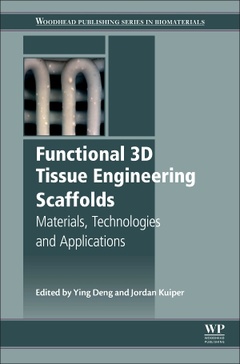Description
Functional 3D Tissue Engineering Scaffolds
Materials, Technologies, and Applications
Coordinators: Deng Ying, Kuiper Jordan
Language: English
Subjects for Functional 3D Tissue Engineering Scaffolds:
Keywords
3D printing; 3D scaffold; 3D scaffold fabrication techniques; 3D-Bioplotter; Additive manufacturing (AM); Bioactive molecules; Bioceramics; Biomaterials; Biomedical textiles; Biomimetic; Biopolymers; Cardiovascular disease; Cartilage regeneration; Cartilage tissue engineering; Cell culture; Cell scaffold interaction; Collagen molecules; Composite; Composite scaffolds; Compression molding; Continuous phase rheology; Dental biomaterials; Direct 3D printing; Drug discovery; Electrospinning; Endodontic regeneration; Engineered heart tissue; Extrusion; Extrusion-based 3D printing; Fiber-based; Foam templating; Foams; Freeze-drying; Functional; Functional scaffolds; Fused deposition modeling; Injection molding; Mechanical properties; Microfluidic foaming; Molding technologies; Morphology; Myoblast; Natural polymers; Neural engineering; Nonwoven textiles; Particulate leaching; Periodontal regeneration; Phase separation; Polymers; Porosity; Primary structure; Regenerative medicine; Satellite cell; Scaffold; Scaffold design; Scaffold engineering; Scaffolding; Scaffolds; Selective laser sintering; Silk fibroin; Skeletal muscle; Skin; Stereolithography; Surface functionalization; Surface pysicochemical characterization; Synthetic polymers; Tendon; Tendon-bone interface; Thermally induced phase separation; Thermodynamic interactions; Three-dimensional scaffolds; Tissue engineering; Tissue engineering (TE); Tissue regeneration; Tooth tissue engineering; Wound healing
Support: Print on demand
Description
/li>Contents
/li>Biography
/li>Comment
/li>
In order to grow replacement tissues, 3D scaffolds are widely used as a template for tissue engineering and regeneration. These scaffolds, which are typically ?seeded? with cells, support the growth of new tissues. However, in order to achieve successful tissue growth, the scaffold must meet specific requirements and are often ?functionalized? to accentuate particular properties. Functional 3D tissue engineering scaffolds: materials, technologies, and applications, is a comprehensive review of functional 3D scaffolds, providing information on the fundamentals, technologies, and applications.
Part 1 focuses on the fundamentals of 3D tissue scaffolds, examining information on materials, properties, and trends. Part 2 discusses a wide range of conventional technologies for engineering functional 3D scaffolds, leading the way to a discussion on CAD and advanced technologies for functional 3D scaffold engineering. Chapters in part 3 study methods for functionalizing scaffolds to support a variety of in vivo functions whilst the final set of chapters provides an important review of the most significant applications of functional 3D scaffolds within tissue engineering.
This book is a valuable resource for biomaterial scientists and biomedical engineers in academia and industry, with interests in tissue engineering and regenerative medicine.
1. Introduction 2. Mechanical and biological properties of scaffold materials 3. Natural materials for 3D scaffolds 4. Bone/neural applications 5. Melt molding technologies for 3D scaffold engineering 6. Phase separation technologies for 3D scaffold engineering 7. Gas foaming technologies for 3D scaffold engineering 8. Freeze drying technologies for 3D scaffold engineering 9. Textile technologies for 3D scaffold engineering 10. 3D printing technologies for 3D scaffold engineering 11. Scaffold functionalization to support tissue biocompatibility 12. Functional Three-Dimensional Scaffolds for Skeletal Muscle Tissue Engineering 13. 3D functional scaffold for cardiovascular tissue engineering 14. 3D functional scaffold for skin tissue engineering 15. 3D functional scaffolds for tendon tissue engineering 16. 3D functional scaffolds for cartilage tissue engineering 17. 3D functional scaffolds for dental tissue engineering
Mr. Jordan Kuiper is a graduate student in the Department of Biomedical Engineering at the University of South Dakota (USD). The research he’s invested in concerns tissue engineering scaffolds, of which he has presented in national and international conferences in both oral and poster presentations. He has won the University of South Dakota’s idea fest twice and is the current Constitution and Bylaws Chair for Society For Biomaterials for USD’s Biomedical Engineering Department.
- Provides a self-contained work for the field of biomaterials and tissue engineering
- Discusses all the requirements a scaffold must meet and a wide range of strategies to create them
- Highlights significant and successful applications of functional 3D scaffolds




